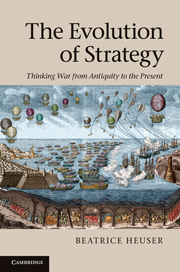Book contents
- Frontmatter
- Contents
- Acknowledgements
- A note on referencing
- Part I Introduction
- PART II Long-term constants
- PART III The Napoleonic paradigm and Total War
- PART IV Naval and maritime Strategy
- 8 Long-term trends and early maritime Strategy
- 9 The age of steam to the First World War
- 10 The World Wars and their lessons for maritime Strategists
- 11 Maritime Strategies in the nuclear age
- PART V Air Power and nuclear Strategy
- PART VI Asymmetric or ‘small’ wars
- PART VII The quest for new paradigms after the World Wars
- Bibliography
- Index
11 - Maritime Strategies in the nuclear age
from PART IV - Naval and maritime Strategy
Published online by Cambridge University Press: 05 June 2012
- Frontmatter
- Contents
- Acknowledgements
- A note on referencing
- Part I Introduction
- PART II Long-term constants
- PART III The Napoleonic paradigm and Total War
- PART IV Naval and maritime Strategy
- 8 Long-term trends and early maritime Strategy
- 9 The age of steam to the First World War
- 10 The World Wars and their lessons for maritime Strategists
- 11 Maritime Strategies in the nuclear age
- PART V Air Power and nuclear Strategy
- PART VI Asymmetric or ‘small’ wars
- PART VII The quest for new paradigms after the World Wars
- Bibliography
- Index
Summary
Come to think of it, I would not put anything on the surface of the ocean – it’s too good a target [for nuclear weapons].
(Edward Teller in the mid-1950s, q.i. Till 1982: 183)The Cold War framework
The interwar period (especially the 1930s) and the Cold War had in common that they were at once characterised by the absence of major war and the ever-present fear of it. The French naval officer Hubert de Moineville rightly commented about the Cold War:
[I]n the state of the world today, and in that unprotected space that is the sea, peace does not really exist. The word is used, mainly as a linguistic convenience, to describe the permanent state of tension in which we live. (Moineville 1982/1983: 9)
What continued in the Cold War was the preoccupation of the matériel school with new technologies and the problems of overall strategic analysis in the context of ever new imponderables presented by technological innovations and revolutions. The focus on fleet action was lost in the preoccupation with all these new technological features (Martin 1967: 10). Similarly, specialists accused NATO and successive Cold War governments of lacking a grand Strategy with regard to the employment of naval power (Hattendorf 1982: 59). Sir Peter Gretton (1912–92), who rose to the rank of Admiral and Fifth Sea Lord and upon his retirement from the Royal Navy became a research fellow at Oxford, thought NATO and US Strategy incoherent:
Here we seem to have the Army and Navy preparing for a long war in which reserves could be used, while the Air Force stressed the Strategic Bomber attack … [the scenario of] a long global war still survived [the Korean War and the advent of thermo-nuclear weapons] as the main reason for which the expansion programme had been planned, though already the talk of broken-backed wars cast doubt on the whole concept … What, in the meantime, had been the development of strategic thought in NATO naval circles and in particular at the Norfolk headquarters of SACLANT? … none. (Gretton 1965: 34f., 44)
Gretton was not the only critic, as the ‘great debate’ about NATO’s nuclear Strategy of those years showed (Aron 1963b). As one of those SACLANT planners commented, ‘[t]he “concept” of fighting a nuclear war was inherently incoherent … Meanwhile the armed services had to strive to develop contingency plans for handling the results’ of a nuclear exchange. They tried to do their best with a ‘surreal’ mission.
- Type
- Chapter
- Information
- The Evolution of StrategyThinking War from Antiquity to the Present, pp. 268 - 294Publisher: Cambridge University PressPrint publication year: 2010



